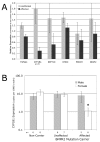Gene expression in BMPR2 mutation carriers with and without evidence of pulmonary arterial hypertension suggests pathways relevant to disease penetrance
- PMID: 18823550
- PMCID: PMC2561034
- DOI: 10.1186/1755-8794-1-45
Gene expression in BMPR2 mutation carriers with and without evidence of pulmonary arterial hypertension suggests pathways relevant to disease penetrance
Abstract
Background: While BMPR2 mutation strongly predisposes to pulmonary arterial hypertension (PAH), only 20% of mutation carriers develop clinical disease. This finding suggests that modifier genes contribute to FPAH clinical expression. Since modifiers are likely to be common alleles, this problem is not tractable by traditional genetic approaches. Furthermore, examination of gene expression is complicated by confounding effects attributable to drugs and the disease process itself.
Methods: To resolve these problems, B-cells were isolated, EBV-immortalized, and cultured from familial PAH patients with BMPR2 mutations, mutation positive but disease-free family members, and family members without mutation. This allows examination of differences in gene expression without drug or disease-related effects. These differences were assayed by Affymetrix array, with follow-up by quantitative RT-PCR and additional statistical analyses.
Results: By gene array, we found consistent alterations in multiple pathways with known relationship to PAH, including actin organization, immune function, calcium balance, growth, and apoptosis. Selected genes were verified by quantitative RT-PCR using a larger sample set. One of these, CYP1B1, had tenfold lower expression than control groups in female but not male PAH patients. Analysis of overrepresented gene ontology groups suggests that risk of disease correlates with alterations in pathways more strongly than with any specific gene within those pathways.
Conclusion: Disease status in BMPR2 mutation carriers was correlated with alterations in proliferation, GTP signaling, and stress response pathway expression. The estrogen metabolizing gene CYP1B1 is a strong candidate as a modifier gene in female PAH patients.
Figures



References
-
- Lane KB, Machado RD, Pauciulo MW, Thomson JR, Phillips JA, 3rd, Loyd JE, Nichols WC, Trembath RC. Heterozygous germline mutations in BMPR2, encoding a TGF-beta receptor, cause familial primary pulmonary hypertension. The International PPH Consortium. Nat Genet. 2000;26:81–84. - PubMed
-
- Newman JH, Trembath RC, Morse JA, Grunig E, Loyd JE, Adnot S, Coccolo F, Ventura C, Phillips JA, 3rd, Knowles JA, et al. Genetic basis of pulmonary arterial hypertension: current understanding and future directions. J Am Coll Cardiol. 2004;43:33S–39S. - PubMed
-
- Newman JH. Treatment of primary pulmonary hypertension – the next generation. N Engl J Med. 2002;346:933–935. - PubMed
Grants and funding
LinkOut - more resources
Full Text Sources
Molecular Biology Databases
Research Materials
Miscellaneous

